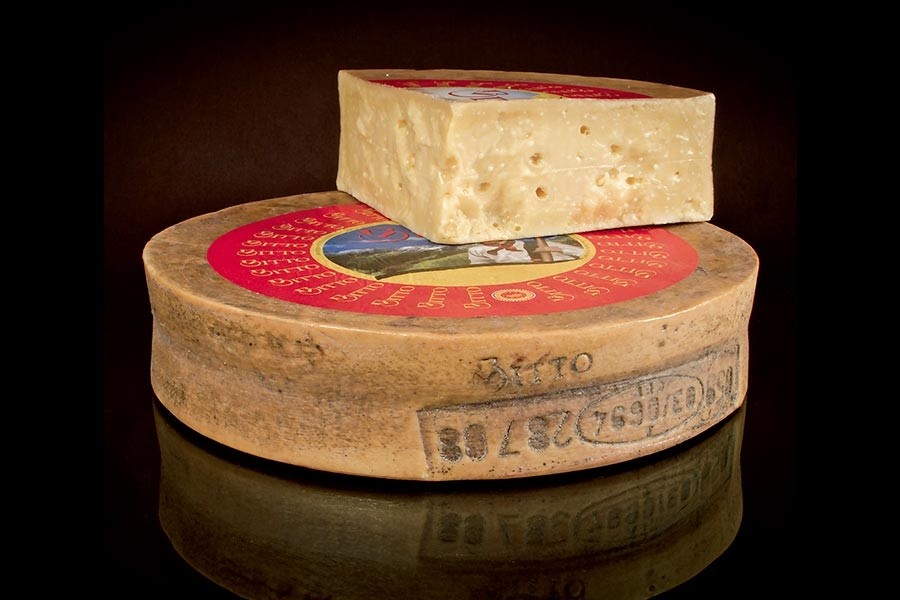Bitto Cheese P.D.O.
Product description
Bitto PDO is a mature semi-hard cheese produced with whole cow’s milk, with the possible addition of raw goat’s milk, no more than a total of 10%.
Production method
The cow’s milk must come from traditional cattle breeds of the production area that are pasture-grazed.
The raw goat’s milk must also come from free range pasture-grazed animals. Both types of milk must be processed within an hour of milking;
the milk is put in traditional copper boilers with the shape of an upside down bell, where it is heated over a medium flame fuelled by wood.
The curd, which is obtained with the use of calf rennet, is cooked at between 48-52°C for around 30 minutes and is broken until the grains are
the size of a rice grain. The mass is placed in the traditional fascere, wooden or plastic molds that give the cheese its curved shape.
The molds possess the indispensable characteristics of breathability and porosity, which are necessary for the salting and ripening process.
Dry salting or brining is used. The minimum period of ripening is 70 days, but the cheese forms can also be left to mature for several years without the organoleptic characteristics or structure altering. In these cases, the cheese is periodically turned, cleaned and rinsed.
Bitto PDO is produced between June 1st and September 30th.
Apparence and flavour
Bitto PDO has a straw yellow rind and a compact interior that ranges from white to pale yellow, depending on how mature it is.
There are sparse eyes the size of corn kernels. It has a sweet and delicate flavour. With aging, Bitto PDO becomes more compact,
richer on the palate and acquires a strong and aromatic taste.
Gastronomia
Bitto PDO keeps extremely well: the ripening process can in fact last for up to ten years.
It should be conserved on the bottom shelf of the fridge, protected with aluminium foil.
Fresh, it is an excellent table cheese to serve with dried fruits, sprinkled with balsamic vinegar and accompanied by rye bread.
It can also be used as a quality ingredient in numerous traditional Valtellinese dishes: it is the primary ingredient for pizzoccheri and taragna polenta, as well as completing dishes such as risotto, baked pasta and fondue.
The mature cheese forms are used for grating. Bitto PDO pairs well with local wines: Valtellina Superiore PDO, Inferno and Sassella.
Marketing
The product is marketed as Bitto PDO. It is sold fresh, mature, whole, in large pieces, or in pre-packed slices. The rind must bear the fire-branded product logo.
Distinctive features
The ripening process of Bitto PDO begins in the alpine dairies and is concluded in suitable environments located in the valley, taking full advantage of the natural weather conditions of the production area.
History
According to several historians, livestock rearing in the Alpine valleys was started by the Celts.
The custom of raising milk-giving animals in the Alpine regions during the summer has continued ever since, alongside the tradition of transforming milk into cheese. The name Bitto derives from the Celtic word bitu, meaning “perennial”.
The Celtics most likely gave this name to the cheese due to the fact that processing the milk permitted them to produce a food product that could be preserved. Morbegno was the most important city for selling Bitto, and since the beginning of the XIX century the city has hosted an annual fair in honour of the cheese, which is now also well-known in the neighbouring valleys.
Production area
The production area of Bitto PDO is within the entire territory of the Province of Sondrio and in the neighbouring territories of other municipal areas in the provinces of Bergamo and Lecco, in the Lombardy region.
Operators: 82
Production(KG): 229.736
Turnover(MLN€): 2,25

 IT
IT 